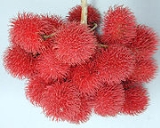
Nephelium
Encyclopedia
Nephelium is a genus of about 25 species of flowering plant
s in the family Sapindaceae
, native to southeastern Asia
.
They are evergreen
tree
s with pinnate
ly compound leaves
, and edible drupaceous
fruit
; one species, N. lappaceum (Rambutan
) is commercially important for its fruit. The genus is closely related to Litchi
and Dimocarpus
.
Selected species
Flowering plant
The flowering plants , also known as Angiospermae or Magnoliophyta, are the most diverse group of land plants. Angiosperms are seed-producing plants like the gymnosperms and can be distinguished from the gymnosperms by a series of synapomorphies...
s in the family Sapindaceae
Sapindaceae
Sapindaceae, also known as the soapberry family, is a family of flowering plants in the order Sapindales. There are about 140-150 genera with 1400-2000 species, including maple, horse chestnut and lychee....
, native to southeastern Asia
Asia
Asia is the world's largest and most populous continent, located primarily in the eastern and northern hemispheres. It covers 8.7% of the Earth's total surface area and with approximately 3.879 billion people, it hosts 60% of the world's current human population...
.
They are evergreen
Evergreen
In botany, an evergreen plant is a plant that has leaves in all seasons. This contrasts with deciduous plants, which completely lose their foliage during the winter or dry season.There are many different kinds of evergreen plants, both trees and shrubs...
tree
Tree
A tree is a perennial woody plant. It is most often defined as a woody plant that has many secondary branches supported clear of the ground on a single main stem or trunk with clear apical dominance. A minimum height specification at maturity is cited by some authors, varying from 3 m to...
s with pinnate
Pinnate
Pinnate is a term used to describe feather-like or multi-divided features arising from both sides of a common axis in plant or animal structures, and comes from the Latin word pinna meaning "feather", "wing", or "fin". A similar term is pectinate, which refers to a comb-like arrangement of parts...
ly compound leaves
Leaf
A leaf is an organ of a vascular plant, as defined in botanical terms, and in particular in plant morphology. Foliage is a mass noun that refers to leaves as a feature of plants....
, and edible drupaceous
Drupe
In botany, a drupe is a fruit in which an outer fleshy part surrounds a shell of hardened endocarp with a seed inside. These fruits develop from a single carpel, and mostly from flowers with superior ovaries...
fruit
Fruit
In broad terms, a fruit is a structure of a plant that contains its seeds.The term has different meanings dependent on context. In non-technical usage, such as food preparation, fruit normally means the fleshy seed-associated structures of certain plants that are sweet and edible in the raw state,...
; one species, N. lappaceum (Rambutan
Rambutan
The rambutan is a medium-sized tropical tree in the family Sapindaceae, and the fruit of this tree. It is native to Vietnam, Indonesia, the Philippines, Sri Lanka, Malaysia, and elsewhere in Southeast Asia, although its precise natural distribution is unknown. It is closely related to several...
) is commercially important for its fruit. The genus is closely related to Litchi
Lychee
The lychee is the sole member of the genus Litchi in the soapberry family, Sapindaceae. It is a tropical and subtropical fruit tree native to Southern China and Southeast Asia, and now cultivated in many parts of the world...
and Dimocarpus
Dimocarpus
Dimocarpus is a genus of about 20 species of flowering plants in the soapberry family Sapindaceae, native to tropical southeast Asia and northern Australasia, from Sri Lanka and southern China south to northern Queensland. The fruit is edible, with the Longan Dimocarpus is a genus of about 20...
.
Selected species
|
Pulasan The pulasan, Nephelium mutabile Blume , is a tropical fruit closely allied to the rambutan and sometimes confused with it... - Pulasan Nephelium xerospermoides Nephelium xerospermoides is a species closely related to the Rambutan. The drupe fruit has a flavor similar to Rambutan. The fruit does not have any hair-like spines, hence its common name. They can be eaten freshly picked from the tree. They are not commonly grown or harvested for commercial use.... - Hairless Rambutan |

